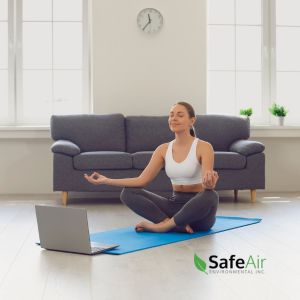Why You Might Have Difficulty Breathing at Home
Posted in Air Quality, on August 11, 2023
Breathing is so fundamental to human life that we don’t notice its presence until there’s a disruption. This summer, clients of SafeAir across Southern Ontario saw a reduction in air quality from wildfire smoke and other pollutants, triggering a wave of requests for air quality inspection in Toronto. This service can help you clean up and protect your indoor air environment, creating a safe haven for you and your family. Our environmental assessments and home air quality testing in Toronto look at your entire home environment to identify common allergens, triggers, and chronic problems that affect sleep, energy, skin, and more.
Common Indoor Contaminants
 Air is never just ‘pure’ — various particles, gasses, and other substances always float through it. Some of the most common indoor contaminants that SafeAir discovers include:
Air is never just ‘pure’ — various particles, gasses, and other substances always float through it. Some of the most common indoor contaminants that SafeAir discovers include:
- VOCs from scented products.
- Mold spores.
- Dander.
- Radon gas.
- Dust mites.
- Pollen.
The Risks of Contamination
If these particles are always in our air, then what’s the worry? While these contaminants may not be harmful in low quantities or outdoors, in your home it’s another story. Poor or stagnant airflow, architecture, use, or problems like floods or high humidity can all contribute to the concentration and accumulation of allergens in an indoor environment. This concentration poses a risk — physical and mental reactions are inevitable when your body lives, sleeps and relaxes in an environment affected by indoor pollution.
Signs of Poor Indoor Air Quality
If you’re wondering how you can tell if your home is affected by some of the common indoor contaminants, there are two avenues that SafeAir recommends. The first is to book an environmental assessment in Toronto with us! Naturally, we believe a whole-home assessment is one of the best investments you can make for your home. Leave the guesswork up to us — we’ll investigate your home inside and out to determine what risks are present, what signs and symptoms we find, and what type and concentration of pollutants appear on our tests.
The second option is for the homeowner to remain vigilant to changes and environmental fluctuations. We recommend looking out for signs such as:
- Strange smells or odours.
- Discolouration.
- High heating and cooling bills.
- High humidity.
- Problems sleeping.
- Itchy skin or eyes.
- Dry hair.
The Benefits of an Environmental Assessment
While the human body is sensitive, it’s not exact, so a professional air quality assessment is always our preferred option. At SafeAir, our approach is guided by professional standards and assessment protocols from internationally-recognized associations regulating our industry and following guidelines by Health Canada and the WHO. This results in impartial and science-based testing, which we believe provides the best and safest outcome for you and your family.
Don’t leave air quality testing up to your nose — if you can smell something strange, it’s probably too late, and some more serious contaminants, like radon gas, don’t have a smell and are impossible to detect without specialized tools.
To learn more about SafeAir and air quality inspection in Toronto, reach out to the team online or by phone to book a consultation.

